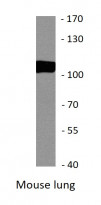ARG40333
anti-ITPKB antibody
anti-ITPKB antibody for Western blot and Human,Mouse,Rat
Overview
| Product Description | Rabbit Polyclonal antibody recognizes ITPKB |
|---|---|
| Tested Reactivity | Hu, Ms, Rat |
| Tested Application | WB |
| Host | Rabbit |
| Clonality | Polyclonal |
| Isotype | IgG |
| Target Name | ITPKB |
| Antigen Species | Human |
| Immunogen | Recombinant fusion protein corresponding to aa. 1-260 of Human ITPKB (NP_002212.3). |
| Conjugation | Un-conjugated |
| Alternate Names | IP3K B; Inositol-trisphosphate 3-kinase B; InsP 3-kinase B; IP3K-B; IP3-3KB; IP3KB; IP3 3-kinase B; EC 2.7.1.127; PIG37; IP3K; Inositol 1,4,5-trisphosphate 3-kinase B |
Application Instructions
| Application Suggestion |
|
||||
|---|---|---|---|---|---|
| Application Note | * The dilutions indicate recommended starting dilutions and the optimal dilutions or concentrations should be determined by the scientist. | ||||
| Positive Control | Mouse lung | ||||
| Observed Size | ~ 105 kDa |
Properties
| Form | Liquid |
|---|---|
| Purification | Affinity purified. |
| Buffer | PBS (pH 7.3), 0.02% Sodium azide and 50% Glycerol. |
| Preservative | 0.02% Sodium azide |
| Stabilizer | 50% Glycerol |
| Storage Instruction | For continuous use, store undiluted antibody at 2-8°C for up to a week. For long-term storage, aliquot and store at -20°C. Storage in frost free freezers is not recommended. Avoid repeated freeze/thaw cycles. Suggest spin the vial prior to opening. The antibody solution should be gently mixed before use. |
| Note | For laboratory research only, not for drug, diagnostic or other use. |
Bioinformation
| Database Links | |
|---|---|
| Gene Symbol | ITPKB |
| Gene Full Name | inositol-trisphosphate 3-kinase B |
| Background | The protein encoded by this protein regulates inositol phosphate metabolism by phosphorylation of second messenger inositol 1,4,5-trisphosphate to Ins(1,3,4,5)P4. The activity of this encoded protein is responsible for regulating the levels of a large number of inositol polyphosphates that are important in cellular signaling. Both calcium/calmodulin and protein phosphorylation mechanisms control its activity. [provided by RefSeq, Jul 2008] |
| Calculated MW | 102 kDa |
Images (1) Click the Picture to Zoom In






